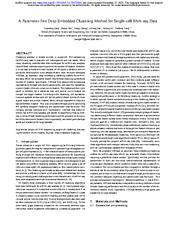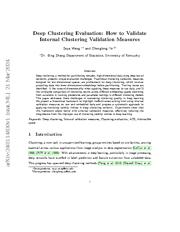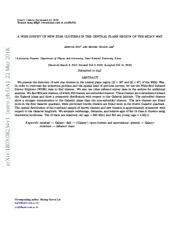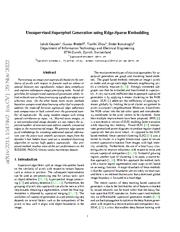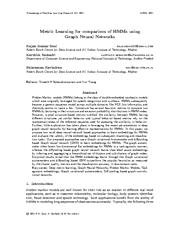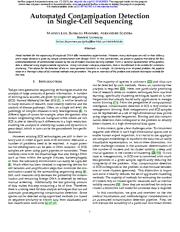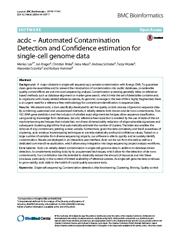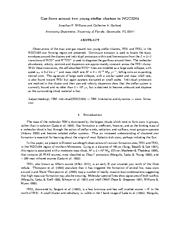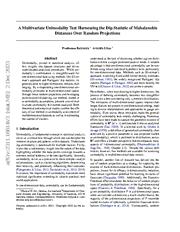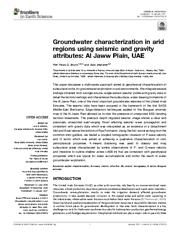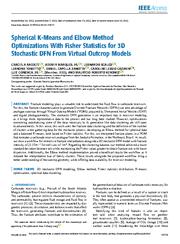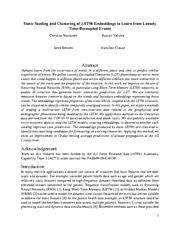A copy of this work was available on the public web and has been preserved in the Wayback Machine. The capture dates from 2022; you can also visit the original URL.
The file type is application/pdf.
Filters
A Parameter-free Deep Embedded Clustering Method for Single-cell RNA-seq Data
[article]
2021
bioRxiv
pre-print
Here, we have developed ADClust, an automatic deep embedding clustering method for scRNA-seq data, which can accurately cluster cells without requiring a predefined number of clusters. ...
clusters. ...
Early popular algorithms are variants of K-means that divide cells into K clusters with K as the pre-determined cluster number. ...
doi:10.1101/2021.12.19.473334
fatcat:fkoyevifwvdgbcognbqoyxy7ce
Deep Clustering Evaluation: How to Validate Internal Clustering Validation Measures
[article]
2024
arXiv
pre-print
Experiments show that this framework aligns better with external validation measures, effectively reducing the misguidance from the improper use of clustering validity indices in deep learning. ...
Traditional clustering validation measures, designed for low-dimensional spaces, are problematic for deep clustering, which involves projecting data into lower-dimensional embeddings before partitioning ...
Attention-based deep Ronen, Meitar, Finder, Shahaf E, & Freifeld, Oren. 2022. Deepdpm: Deep clustering with an on Artificial Intelligence, vol. 32. ...
arXiv:2403.14830v1
fatcat:3xkintjke5fozif5crensvay7a
A WISE Survey of New Star Clusters in the Central Plane Region of the Milky Way
2018
Astrophysical Journal
The embedded clusters show a stronger concentration to the Galactic plane than the non-embedded clusters. ...
We find 923 new clusters, of which 202 clusters are embedded clusters. ...
We estimate the distances to the known embedded clusters near the four peaks based on their radii, and describe the distance distributions in Figure 13 (a). ...
doi:10.3847/1538-4357/aab1ff
fatcat:ttngusnccfflrlh7yk2jr647bm
Unsupervised Superpixel Generation using Edge-Sparse Embedding
[article]
2022
arXiv
pre-print
We generate edge-sparse pixel embeddings by encoding additional spatial information into the piece-wise smooth activation maps from the decoder's last hidden layer and use a standard clustering algorithm ...
On the other hand, more recent methods based on unsupervised deep learning either fail to properly address the trade-off between superpixel edge adherence and compactness or lack control over the generated ...
While the Double-DIP seems to work on natural images with a saliency estimate, it does not converge on noisy microscopic data which is why we decided to stop the optimization after 500 steps. ...
arXiv:2211.15474v2
fatcat:tmao6uvlnvajrmeodqofw7wpuq
Metric Learning for comparison of HMMs using Graph Neural Networks
2021
Asian Conference on Machine Learning
In this paper, we propose two novel deep neural network based approaches to learn embeddings for HMMs and evaluate the validity of the embeddings based on subsequent clustering and classification tasks ...
Empirical results reveal that the HMM embeddings learnt through the Graph variational autoencoders and diffpooling based GNN outperform the popular heuristics as measured by the cluster quality metrics ...
As the number of test samples increases, the accuracy of the MST based clustering output dips sharply for the graph autoencoder based embedding. Number of Audio files vs. ...
dblp:conf/acml/SoniSR21
fatcat:3ybqkx4h5vckpfivlgfspiowfu
Automated Contamination Detection in Single-Cell Sequencing
[article]
2015
bioRxiv
pre-print
However, many techniques are still in their infancy and a major obstacle is given by sample contamination with foreign DNA. ...
Using non-linear subspace projections, data is transformed to be suitable for automatic clustering. This allows for the detection of one vs. more genomes (clusters) in a sample. ...
III.6 Dip-means Using the Dip Statistic [11] , Dip-means [15] is based on a significance test for multimodality. ...
doi:10.1101/020859
fatcat:gtczlaqrcvdgpfojzuvsfg74yu
acdc – Automated Contamination Detection and Confidence estimation for single-cell genome data
2016
BMC Bioinformatics
algorithms that automatically estimate the number of clusters. ...
A major obstacle in single-cell sequencing is sample contamination with foreign DNA. ...
For this task, an optimal clustering has to be estimated. While CC provides an optimal assignment by itself, for DIP the number of clusters k has to be estimated. ...
doi:10.1186/s12859-016-1397-7
pmid:27998267
pmcid:PMC5168860
fatcat:e3w4tpqmrzhjvd43thjzu3c7di
Gas Flows around Two Young Stellar Clusters in NGC 2264
2002
Astrophysical Journal
With these constraints, the self-absorbed HCO+ lines are modeled as a large scale collapse, with speed v_in=0.3 km/s and mass infall rate dM/dt=4e-4 Msun/yr, falling onto an expanding central core. ...
Observations of the dust and gas toward two young stellar clusters, IRS1 and IRS2, in the NGC2264 star forming region are presented. ...
Core c shows the clearest infall signature with a deep, red-shifted, absorption dip. ...
doi:10.1086/338837
fatcat:a4iv2x6ivfdd3lcucveib27ktm
A Multivariate Unimodality Test Harnessing the Dip Statistic of Mahalanobis Distances Over Random Projections
[article]
2023
arXiv
pre-print
Both theoretical and empirical studies confirm the efficacy of our method in unimodality assessment of multidimensional datasets as well as in estimating the number of clusters. ...
While unimodality's confirmation is straightforward for one-dimensional data using methods like Silverman's approach and Hartigans' dip statistic, its generalization to higher dimensions remains challenging ...
Given our design's adherence to the original dataspace, we exclude methods combining learning embeddings and clustering, like deep clustering approaches. ...
arXiv:2311.16614v3
fatcat:aniiwglpnbhinoxgo7rta5hw74
Groundwater characterization in arid regions using seismic and gravity attributes: Al Jaww Plain, UAE
2021
Frontiers in Earth Science
K-means clustering was used to classify and map subsurface areas characterized by similar observations of P- and Q-wave velocity and therefore to outline shallow zones (<600 m) that are consistent with ...
We integrate several findings obtained from a single-source, single-sensor seismic profile with gravity data to detail the tectonic settings and characterize the subsurface, water-bearing formations of ...
ACKNOWLEDGMENTS The authors thank EAGE (European Association of Geoscientists and Engineers) for co-organizing the First EAGE Middle-East BootCamp, together with other former colleagues of the Khalifa ...
doi:10.3389/feart.2020.575019
fatcat:ooxhrwbtcjebbg5fgwnb4ukqca
Spherical K-Means and Elbow Method Optimizations With Fisher Statistics for 3D Stochastic DFN From Virtual Outcrop Models
2022
IEEE Access
a balanced K-means, both based on Fisher statistics. ...
Regarding the clustering balance, our method achieved a lower standard deviation between sets while maintaining the Fisher values greater to obtain fracture sets with lower dispersion. ...
SPHERICAL DATA CLUSTERING The basic K-means algorithm clusters objects in sets of K defined clusters, with random centroid clusters initially set in the first iteration. ...
doi:10.1109/access.2022.3182332
fatcat:osw2jm75ejghpeu3ikxkafql5m
Deep data mining in a real space: separation of intertwined electronic responses in a lightly doped BaFe2As2
2016
Nanotechnology
In many correlated electron systems, however, the parent or underdoped states exhibit strongly inhomogeneous electronic landscape at the nanoscale that may be associated with competing, coexisting, or ...
Here we demonstrate an approach based on a combination of scanning tunneling microscopy/spectroscopy (STM/S) and advanced statistical learning for an automatic separation and extraction of statistically ...
Based on the results shown in Fig. 3b, we used 3 clusters as an input in our k-means analysis. ...
doi:10.1088/0957-4484/27/47/475706
pmid:27780159
fatcat:ybxe6ko4h5dmposdx3fdmepav4
Multiview-Consistent Semi-Supervised Learning for 3D Human Pose Estimation
[article]
2020
arXiv
pre-print
Our framework applies hard-negative mining based on temporal relations in multi-view videos to arrive at a multi-view consistent pose embedding. ...
When jointly trained with limited 3D pose annotations, our approach improves the baseline by 25% and state-of-the-art by 8.7%, whilst using substantially smaller networks. ...
Analysis of Learned Embedding In this section, we demonstrate the quality of our learned embedding in capturing 3D human-pose by showing i) pose based cluster formation in our embedding space through retrieval ...
arXiv:1908.05293v3
fatcat:35thk5rmcjfwtbfads7ej5mmty
The Hydrothermal System of Solfatara Crater (Campi Flegrei, Italy) Inferred From Machine Learning Algorithms
2019
Frontiers in Earth Science
The first algorithm includes a new approach for a soft K-means clustering based on the use of the silhouette index to control the color palette of the clusters. ...
Comparison between the results of K-means and self-organizing maps on the datasets with the largest number of nodes confirms that, with respect to the K-means, self-organizing maps compress the data in ...
In the second part of our paper, we link, with K-means clustering, the tomographic P-wave velocity profiles from Bruno et al. (2017) , with the overlapping electric resistivities estimated by Gresse ...
doi:10.3389/feart.2019.00286
fatcat:6ntk2mdtuzbmtagt4saaq4rjwa
Static Seeding and Clustering of LSTM Embeddings to Learn from Loosely Time-Decoupled Events
[article]
2022
arXiv
pre-print
The embeddings represent properties of the event which, coupled with the LSTM structure, can be clustered to identify similar temporally unaligned events. ...
We use similarity measures between timeseries based on the trends and introduce embeddings representing those trends. ...
embedding-based clustering. ...
arXiv:2208.12389v1
fatcat:sonjsak7l5fxrmunwblmfaefxy
« Previous
Showing results 1 — 15 out of 9,481 results

